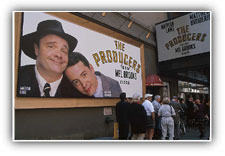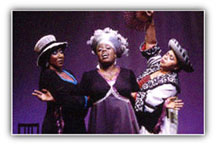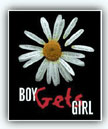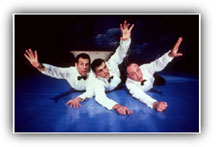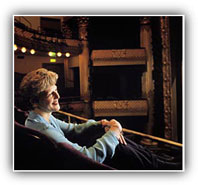Theater: Playwrights New and Old
By Chris Jones

|
Spring comes early in Montgomery, Alabama. But while the resplendent grounds of the Alabama Shakespeare Festival --which is perhaps America's most beautiful theater -- are especially verdant in the first months of the year, it's one of the Festival programs, the Southern Writers' Project, that attracts the arts world to the cradle of the civil rights movement. Each year, over the course of several days, the Southern Writers' Project puts on half a dozen or more new plays by aspiring and established playwrights.
The Southern Writers' Project is not the only place to see the latest up-and-comers in the flowering field of American playwriting, however. The spring Humana Festival of New American Plays at the Actors Theatre of Louisville offers an even better-known slate of works -- including, in 2003, a dazzling and wildly popular new play called Omnium-Gatherum.
Penned by Alexandra Gersten-Vassilaros and Theresa Rebeck, this intensely stimulating dissection of American geopolitical views imagines a dinner party thrown by Martha Stewart immediately after the terrorist attacks of September 11, 2001. With characters based partly on known American intellectuals, the "guests" represent a broad variety of political points of view. And judging by the response in Kentucky, American audiences clearly are hungry to debate America's place in the world.
On and Off Broadway
The daring and laudably frank Omnium-Gatherum appears headed for Broadway. There was a time once in American theater when new plays typically opened on Broadway. For some years, however, the nonprofit American theaters -- often called resident theaters or regional theaters -- and their for-profit counterparts have enjoyed a lively give-and-take when it comes to the propagation of new American works for the stage. Some new plays begin in the commercial arena and flow to the regional nonprofits. Others move in the opposite direction -- spawning in Louisville or Montgomery and ending up, like Donald Margulies's Dinner With Friends, in major commercial productions. Nowadays, these two branches of an American theater industry forever hungry for new products feed each other -- in roughly equal measure.
Indeed, the old stereotype of commercial producers as avaricious entrepreneurs looking only for lowest-common-denominator entertainment long has been outmoded. These days, commercial producers are, first and foremost, theater lovers looking for vibrant and progressive new American works. And they're willing to get behind even risky plays that catch their eye.
Musicals may still rule on Broadway, but it also launches some great new American plays, such as Richard Greenberg's Take Me Out. A drama about a gay baseball player, Greenburg's play was a finalist for the 2003 Pulitzer Prize for drama.
Still, visits to this year's new plays in Alabama and Kentucky were an apt indicator of the breadth and diversity of the new work being developed by a new generation of playwrights. American theater has long been distinguished by playwrights' efforts to explore current social issues on stage, and the new generation of playwrights continues that tradition.
Fresh Voices
Carlyle Brown, a remarkable scribe currently best known for his The African Company Presents Richard III, penned and self-performed The Fula From America, wherein he explores the mythic and practical place of a modern-day African American on a bus journeying through the bush of the African motherland. In Brown's capable hands, this strange trip through the African continent becomes a real tour-de-force that is full of rich global characters and wry social commentary, and recalls the very best work of such great American monologists as Lili Tomlin. As it ponders the perennial questions of whether one can ever truly return home again and the changing role of the American abroad, The Fula feels fresh, wise, and realistic.
Meanwhile, the politically charged playwright Kia Corthron -- an important new American writer and the author of the recent New York hit about girl gangs called Breath, Boom -- offered a provocative new work called The Venus de Milo Is Armed, which deals with the global horrors of landmines from a uniquely American perspective. Herein, Corthron imagines landmines exploding in the United States, as a means of getting her domestic audiences to relate to this global problem.
And as light relief, a hitherto unknown Alabama writer named Linda Byrd Killian penned Aaronville Dawning, a funny and gossipy Southern gothic tale of an elderly woman from Mississippi who chats with the audience, from her kitchen, about her life and local characters as she prepares food for a funeral. Droll and wise, it is like a southern version of Having Our Say, the splendid work from the last decade about the Harlem-born Delaney sisters.
Taken together, this remarkably disparate trio of works offered ample evidence that modern American theaters strive more and more for works that reflect a broad collection of voices, especially those we do not hear all that often.
Other playwrights -- including the likes of Regina Taylor -- were in the audience for the event. Increasingly, the Alabama Shakespeare Festival has become the venue of choice to see important southern writers -- including the Alabama-born Rebecca Gilman, who has emerged in the last five years to become one of the most important new voices in the American theater.
Profile: Playwright Regina Taylor
Regina Taylor was approached several years ago by the director of a theater company in Princeton, New Jersey, and asked to create a stage drama out of a volume of vintage black-and-white photographs of African-American women in "going-to-church" hats. Taylor was galvanized by the challenge. The result was Crowns, a blending of gospel music and old-fashioned storytelling centering on these women. The playwright/actress shaped the drama in part during a residency at actor Robert Redford's Sundance Institute in Utah, and unveiled her play in the New Jersey college community late in 2002. "We're doing the truths of their lives," Taylor noted shortly before the premiere of Crowns. Citing the revelatory nature of the hats, she called them "wonderful windows into these women's souls." Crowns, which has drawn considerable attention since its debut, is only the latest example of its author's creative and intellectual prowess. Taylor is a renaissance woman for her time. Actress, director, and playwright, she has journeyed throughout the world of the performing arts over the past two decades. The daughter of two schoolteachers, Taylor grew up in Dallas, Texas, and was still an undergraduate, majoring in journalism and English, when she made her professional acting debut in a television movie -- a docudrama about the history of school integration in the U.S. South. After graduation, Taylor moved to New York City in 1981 to continue acting -- a craft to which she had been directed by one of her writing instructors in college. "I became fascinated with the process of acting," she told an interviewer recently. "With writing you put pen to paper. It's the flesh and blood, as it were. In acting, you're giving your voice and body to the spirits." As a stage performer, Taylor was the first African-American woman to star as Juliet in Romeo and Juliet on Broadway. In television, she won a Golden Globe Award for her depiction of an African-American woman in the U.S. South in the 1950s in the acclaimed television series "I'll Fly Away." In films, she has been a steady presence opposite such actors as Denzel Washington and Samuel L. Jackson. Taylor's first play, Oo-Bla-Dee, which focused on black female jazz musicians in the 1940s, debuted at a theater in Chicago and had subsequent stagings elsewhere. She then adapted Chekhov's The Cherry Orchard into Drowning Crow, using a rural setting in contemporary South Carolina to present the story of a generational split in an artistic family. Now, with Crowns having had a New York staging after its Princeton engagement, Taylor is setting her sights on one of her next projects, a stage adaptation of Alice Walker's novel The Color Purple -- at the specific request of the author. |
A modest and unassuming woman in her mid-thirties, Gilman came to Chicago from Trussville, Alabama. After initially collecting fistfuls of rejection letters, Gilman's big break came when a tiny Chicago-area theater company called the Circle Theatre in Forest Park produced one of her early plays, The Glory of Living, an unflinching exploration of child abuse, sexual deviance, and serial murder. Favorable reviews reached the ears of Susan Booth, then literary manager of Chicago's prestigious Goodman Theatre (now the artistic director of the growing Alliance Theatre in Atlanta), and Gilman quickly became the Goodman's favorite daughter.
The Goodman premiered Gilman's Spinning Into Butter, a play about white liberal racism. Set on a fictional college campus, that play follows the reaction of the white administrators to the news that an African-American freshman student has been receiving threatening and anonymous letters. In the second act, a stressed-out dean of students, Sarah Daniels, loses control in front of a colleague and unleashes a monologue in which she confesses her own racism. Since the character is hitherto empathetic -- and the racism is expressed with the language and logic usually favored by liberals -- the monologue garnered both the play and production enormous attention, as well as a subsequent production at the Manhattan Theatre Club.
|
Since then Gilman has penned Boy Gets Girl (a relationship-oriented, Yuppie-populated drama) and Blue Surge (a piece that probes the connections between the police and the criminals whom they chase). Gilman is a provocative, important playwright and a name to watch.
Probing Controversial Issues
The current American theater certainly does not rely entirely on new names. Writers like Tony Kushner, whose controversial Homebody/Kabul probed issues surrounding the creation of the balance of power in the Middle East, continue to serve as the political provocateurs of the contemporary American theater.
August Wilson has almost completed his grand opus following the African-American experience in each decade of the 20th century -- his dazzling King Hedley II provided ample evidence in 2000 that this remarkably prolific and poetic writer is becoming more and more interested in invading the territory once reserved for the Greek tragedians. In 2003, Wilson is adding Gem of the Ocean to his stunning progression, leaving himself with nine decades covered and just one more to go.
And in the last couple of years, Edward Albee, a grand old man of the American theater, proved that a playwright in his seventies can still shock an audience. Albee's The Goat, or Who Is Sylvia? a domestic tragedy wherein one of the leading characters falls in love with a four-legged animal, won the Tony Award last year for the best original play on Broadway and became one of the most talked about dramas in years. The topic may sound prurient, but that's avowedly not the case. The work actually is a serious and weighty play wherein the taboo love object functions as a metaphor for any "other" in a personal (or, for that matter, political) relationship. The very word "tragedy," after all, has its origins in the term "Goat Song." In the case of the Albee play, the deep themes - which carry great metaphoric weight -- make many younger writers look positively timid in comparison.
Still, several other new American playwrights have come to the fore in the last couple of years. Adam Rapp, an articulate voice of youthful anger who likes to break theatrical rules, has penned works like Nocturne (which probes a young man's journey through the confines of guilt) and Finer Noble Gases, an uber-naturalistic slice-of-life about a bunch of lonely musicians preoccupied with getting and then destroying technology.
|
The rather older Charles L. Mee, an astonishingly complex and gifted playwright, also ploughs a very singular path (including making all of his works available on the Internet and encouraging theater groups to mix and match material as they see fit). Much of Mee's work has been influenced by the classics -- as he proved with his wildly popular Big Love, he's especially fond of modern versions of ancient Greek plays. And Mee's recent and poetic Limonade Tous Les Jours, follows a man to Paris, where a gorgeous young French cabaret singer finds him irresistible. As in all of Mee's works, there's a sense of romance, fantasy, and wisdom.
Mee has frequently collaborated with the director Anne Bogart -- together the duo recently created bobrauschenbergamerica, a dazzling theatrical treatment of the vista of Bob Rauschenberg, the eminent visual artist of the 1950s. Bogart also has penned Score, a recent solo look at the career of the great composer Leonard Bernstein. And she has lent the superb actors who make up her SITI Company to other American playwrights -- including the astounding Jefferson Mays, who will have spent most of 2002 and 2003 working on Doug Wright's I Am My Own Wife, a play about a German transvestite who survives the collapse of the Berlin wall.
Crossing Boundaries
In many ways, Bogart's work (wherein director and author often become inextricably merged) is indicative of the collapse of many of the old boundaries that used to divide the American theater. These days, those newly irrelevant divisions are eroding fast.
The writer-director Mary Zimmerman, whose gorgeous adaptation of Ovid's Metamorphoses was such a great success on Broadway, is what one might think of as a full-service artist. From her version of The Notebooks of Leonardo da Vinci to her remarkable collaboration with Philip Glass on the opera Galileo Galilei at the Goodman Theatre, Zimmerman typically has eschewed anachronism or direct political commentary, but she still has forged an unforgettable link between archetype and the nightly news.
Several times over the last couple of years, Zimmerman had gently coaxed her open-mouthed audience to a shocking place where ancient traditions crashed like powerful waves against the mean, destructive shores of modern life.
Zimmerman is a consummate storyteller. But in the main, the new generation of American theater artists tends to be less interested in traditional narratives -- its video-generation playwrights grew up with an affinity for surrealist images and fast-changing visuals. Writers like the intense, San Francisco-based Denis Johnson (Hellhound on My Trail), the heir apparent to Sam Shepard and a chronicler of the motifs of a semi-mythic American West, often focus on the impact of images rather than cold dramatic logic.
In general, the emerging generation of writers is more intrigued these days by boundary crossings. Take, for example, the mature work of Suzan-Lori Parks, within whose Pulitzer Prize-winning Topdog/Underdog two African-American brothers named Lincoln and Booth share a grungy boardinghouse room. Lincoln even works as an Abe Lincoln impersonator at a penny arcade.
Is this history or a work of fiction? Is it a straightforward tale of sibling rivalry or a grand look at the echoes of the past? As she did with her equally challenging The America Play, Parks blends fact and fancy in the most provocative of fashions.
This self-conscious sense of theatricality -- employed for both Brechtian and humorous purposes -- even has infected the Broadway musical. Greg Kotis and Mark Hollmann's Urinetown, the Musical imagines a world where corporate ownership has run so amuck that residents have to go to privately owned toilets for relief.
The show aims to make a point about the importance of conservation and compassion. But its characters also know that they are, well, characters in a musical. And that lends the whole affair a smart, postmodern sensibility that appeals to younger audience members, even as the show pays homage to the traditions of the Broadway musical -- one of the great American artistic inventions, as Mel Brooks's side-splitting live version of The Producers so aptly reminded us.
One can see this blending tendency in all areas of the arts -- both American museum exhibits and rock concerts are becoming more overtly theatrical than was previously the case, even to the point of employing live actors and dramatic narratives. And Broadway often looks to Hollywood for inspiration and vice-versa -- the Hollywood version of the Broadway musical Chicago was named the best film of 2002 by America's Academy of Motion Picture Arts and Sciences.
Special Effects
Many theaters point out now that their primary competition for audience members comes not from other arts groups but from retail environments that are increasingly theatrical in nature. One store, American Girl Place in Chicago, which caters to the preteen set, even hired Broadway composers and created its own pint-sized musical in the basement of the store. New works of theater, it seems, crop up even in shopping areas.
The theater technology of America is changing, too. Within the last two years, there have been astonishing advances in two-dimensional imagery, with digital images often creating what would in the past have been painted on canvas. Now that moving-light instruments are commonplace, the state-of-the-art theaters (such as the stunning new 4,000-seat Coliseum at Caesar's Palace in Las Vegas) are using massive LED (light emitting diode) screens to create a sense of depth and offer a level of entertainment spectacle available nowhere else in the world.
These days, Las Vegas shows are no longer empty glamour, but complex visual experiences, wherein global artists take advantage of massive budgets and blank aesthetic slates to experiment in the middle of the great American desert. Although lower tech, a similar screen provides the backdrop to the Broadway musical Hairspray, a work that combines the sizzle of "camp" with the kinds of serious civil-rights themes that they well understand in Alabama.
The play is still the thing in contemporary America, but the breadth of the modern theatrical canvases knows no boundaries.
_____Chris Jones is a theater critic with the Chicago Tribune.
A Conversation With Carey Perloff
For almost 20 years, Carey Perloff, artistic director of San Francisco's American Conservatory Theater, has witnessed the evolution of the theater scene across the United States. During her decade at the helm of the prominent A.C.T. troupe -- which has encompassed, among other challenges, the rebuilding of her company's theater space from the ruins of a 1989 earthquake in California -- she has seen the expansion in the pool of creative talent and audiences alike. Her perspective extends beyond the United States as she seeks ideas from her peers around the globe and pursues collaborative ventures. Q: What impresses you as some of the more significant developments in theater during the past decade or so? A: There are several. One is the renaissance of the American actor. It's a great moment. I think about the future of the field a lot, because we have an actor-training program here at American Conservatory Theater that grants a master of fine arts in acting. What we've found is that American actors have a unique fusion of skills -- a wonderful kinetic sense, a big emotional range, and the kind of language and text skills that we have traditionally associated with British theater. The standard of acting, in many different genres around the country, is incredibly high. When my international colleagues come to work with us, they're always amazed that American actors can sing, can dance, can handle a wide variety of styles. I also think that we're crossing disciplines more in general. The boundaries of the well-made play are breaking down. We did a multidisciplinary music theater piece last year with San Francisco's remarkable Kronos Quartet -- a new kind of opera that developed an enthusiastic following. This kind of interdisciplinary work is happening around the country, a healthy reminder of the fact that American theater is truly national, not just based in New York. There's a lot of cross-pollenization among disciplines, which is great, and a strong international influence. We have international artists coming through A.C.T. all the time. Q: What's the greatest challenge facing the American theater community today? A: One is the ongoing fight for idiosyncrasy. There is a real danger that with the ever-tightening economy, theater will become very homogeneous -- that every theater will produce the same kinds of plays, that producers will be scared of taking risks. Really exciting theater is developed for a very particular community at a very particular time, and it needs to become the idiosyncratic voice of that particular venue. That's how theater stays interesting. If you look around the country, there's less surprise in theater seasons than there used to be; they're more predictable. So individual voice is an important issue. Another challenge is keeping major artists in the field. We lose them to the [movie] industry very quickly. The temptations of other resources are so great. Q: What are the creative and artistic influences from abroad that have been significant, from your point of view? A: Ironically, we have the Europeans to thank for keeping great American artists like director Robert Wilson in the field. It's unbelievable that one of the most significant American artists has been employed almost solely by Europeans. Here in San Francisco, there are populations from all over the world, so no matter what kind of material you're working on, you have that population as a resource tool. Q: Are the creative giants of the past -- the O'Neills and the Williamses and their contemporaries -- still dominating the field, or are new voices able to be heard? A: I think it is possible for other people's voices to be heard. I don't know that we have the generation that was Tennessee Williams and Eugene O'Neill and Clifford Odets and Lorraine Hansberry and others. It's always hard to tell that until time has passed. But I think it's a vigorous time for American writing, and it takes a while for voices to emerge. It goes back to risk, though: A theater has to be interested enough in a given writer's voice to support the work through both failure and success. That's how a writer grows. I do think that American audiences have become infinitely more sophisticated than they were a decade ago. We do very challenging plays here at A.C.T. Because we've spent so much time really energizing our audience about unusual material, they relish it. Q: Ten or 12 years ago, the average artistic director outside New York City could not get away with that type of experimentation. A: No. That has evolved. And it's very exciting. And for the artist, it's so much more fun. Q: Here we are at a time of economic downturn. What do you do to compensate? A: This economy has been particularly terrifying on the West Coast. We went through an extraordinary boom in northern California, which allowed A.C.T. to erase our entire post-earthquake deficit and build a huge subscription base. But the combination of the collapse of Silicon Valley and the September 11 terrorist attacks and the recession has been so punishing to California. And yet A.C.T. has had one of the best years we've ever had at the box office. Audiences are incredibly hungry for live theater -- for the whole participatory experience of seeing a play. Like other regional theaters around the country, we do pre-play discussions, post-play discussions, symposia -- everything and anything that helps an audience feel engaged. And we've found that people respond very strongly when they are given a chance to interact. One major cause of the money problems A.C.T. and other nonprofit theaters across the country are experiencing is that the field is chronically under-endowed -- unlike symphony orchestras and art museums. Because we're always thinking about solving the next production, we don't always focus as much as we should on the long-term future, and how we're all going to survive. It becomes very hard to push forward and grow and be ambitious and do the kind of work you want to do, while not taking so many risks that your institution's health is imperiled. It's a very hard call. Q: Speculate, if you will, as to what might happen in theater over the next 10 years. A: What I'm hoping is that more mid-sized theaters will emerge again. It's one of the keys to the whole theater ecology. It's why I wanted A.C.T. to develop a smaller space. As much as it's wonderful to see major productions in a large, glorious space, there's something about the intimacy of a 200-seat theater that is very special. The other thing I'm really fighting for -- because it's the best thing that ever happened to me at A.C.T. -- is the maintenance of a core company of actors. It's an idea that, unfortunately in the last 10 years, has disappeared from almost every American theater. It can be the greatest thing to watch really terrific actors transform in role after role. It's so thrilling. We have a great actor here who has just played the sleaziest, funniest character in [David Mamet's] American Buffalo. And now he's going to play a romantic in Chekhov's The Three Sisters. That lets an audience in on the whole transformative process of theater. _____The interview with Carey Perloff was conducted by Michael J. Bandler. |
To see our Photo Gallery on THEATER go to
http://usinfo.state.gov/journals/itsv/0403/ijse/gallery.htm

Back to top | Contents, U.S. Society & Values, April 2003
